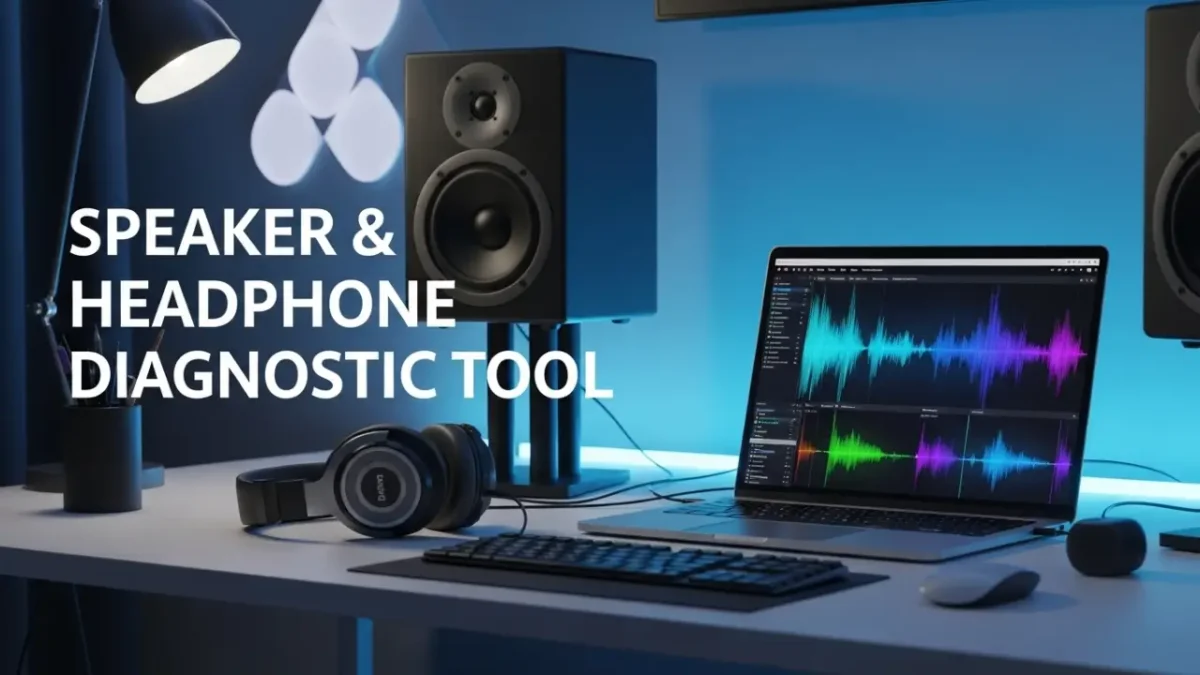Online Speaker Test & Headphone Diagnostic

Our free online speaker test is the ultimate tool for diagnosing and optimizing your speakers and headphones. Designed for gamers, audiophiles, and anyone passionate about high-quality audio, this tool uses advanced pure tone generators and audio visualizers to evaluate frequency response, stereo separation, and physical integrity. Whether you’re setting up a new sound system, troubleshooting a gaming headset, or ensuring your home theater delivers immersive sound, our speaker test online provides precise, actionable results.
Important: Please set your volume to a low, comfortable level before beginning any test.
Speaker & Headphone Diagnostic
Use these tools to test your audio setup's frequency range, stereo separation, and physical integrity. Set your volume to a comfortable level before starting.
Bass Sweep (20Hz - 200Hz)
Listen For: Rattling, buzzing, or distortion at low frequencies. The volume should be consistent across the sweep.
Treble Sweep (8kHz - 22kHz)
Listen For: A clear, smooth tone without harshness. Note the highest frequency you can personally hear.
White Noise
Listen For: A consistent "hiss" centered between your speakers. Unwanted rattling or vibrations can be easily exposed by this test.
Stereo Soundstage
Listen For: A clear tone from the left speaker, followed by the right. This verifies your channels are correctly configured.
How to Use Our Audio Diagnostic Tools
Our suite is designed to test specific aspects of your audio hardware for optimal performance:
- Bass Sweep (20Hz – 200Hz): Detects low-frequency issues like rattling or uneven bass response, ideal for subwoofer testing.
- Treble Sweep (8kHz – 22kHz): Evaluates tweeter performance and high-frequency clarity, perfect for high-resolution audio systems.
- White Noise: Reveals physical defects like loose components or cracked enclosures through full-spectrum sound.
- Stereo Soundstage: Ensures correct left-right channel configuration for immersive audio experiences.
Troubleshooting Common Audio Issues
If your tests reveal issues, here are common problems and solutions:
- Distorted Bass: Check for loose connections or a damaged subwoofer. Ensure your speaker is on a stable surface to avoid vibrations.
- Harsh Treble: Adjust equalizer settings to reduce high frequencies or inspect tweeters for damage.
- Rattling During White Noise: Tighten screws on speaker enclosures or check for debris inside. If persistent, the driver may be blown.
- Incorrect Stereo Channels: Verify your audio settings in your operating system and ensure cables are correctly connected.
For persistent issues, consult a professional audio technician or consider upgrading your equipment for better performance.
Tips for Optimizing Your Audio Setup
Maximize your audio experience with these expert tips:
- Position Speakers Correctly: Place speakers at ear level, angled toward your listening position, to create an ideal soundstage.
- Use High-Quality Cables: Invest in shielded audio cables to reduce interference and improve signal clarity.
- Calibrate Your Equalizer: Adjust bass, mid, and treble settings to match your room’s acoustics or headphone profile.
- Regular Maintenance: Clean your speakers and headphones regularly to prevent dust buildup, which can affect sound quality.
- Test Periodically: Run these diagnostic tests every 6-12 months or after moving your setup to ensure consistent performance.
Why Test Your Audio Setup?
Regular testing ensures your speakers or headphones deliver the best sound quality for gaming, music, movies, or professional audio work. These tests help identify issues like uneven frequency response, damaged drivers, or misconfigured channels, allowing you to address problems early and enhance your listening experience.
Frequently Asked Questions
What is a speaker test?
A speaker test uses audio signals like frequency sweeps or white noise to assess the performance, frequency response, and physical condition of your speakers or headphones.
Why can’t I hear high frequencies in the treble sweep?
It’s normal for adults to lose the ability to hear frequencies above 18kHz due to age-related hearing changes, not equipment failure.
How do I fix rattling in my speakers?
Rattling may indicate loose components, a damaged driver, or enclosure issues. Check connections, tighten screws, and seek professional repair if needed.
How often should I test my audio setup?
Test your audio setup every 6-12 months, after noticing sound quality issues, or when setting up new equipment to ensure optimal performance.
Share Your Feedback
Did our audio diagnostic tools help you optimize your setup? Share your experience or suggest improvements! Your feedback helps us enhance this tool for everyone.
